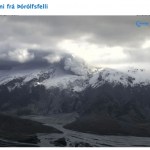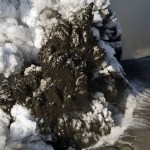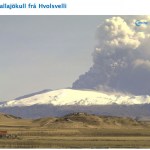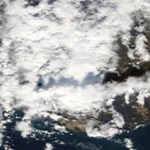Eyjafjöll
The steam plume from a lava flow moving down the slopes of Eyjafjallajökull on May 2, 2010.
A quick note on the activity at Eyjafjallajökull in Iceland: The ash from the ongoing eruption has caused a partial closure of airspace over Ireland from 0600 to 1200 on Tuesday May 4. This is one of the first closures of European airspace since airspace reopened over 10 days ago. This closure is based on the predicted location of ash in flight corridors over Ireland tomorrow.
The Icelandic Met Office has released two interesting updates on the activity at Eyjafjallajökull. The first describes the…
Webcam capture of Eyjafjallajökull erupting on May 2, 2010. You can see the steam plume on the middle flanks of the volcano - this is likely a lava flow coming from the summit vents.
A brief update on activity at Eyjafjallajökull:
Overnight, the lava flows from Eyjafjallajökull could be seen in the crater of the ice cap - some of the images posted by Eruptions readers are simply stunning. You can clearly see the red glow of the strombolian eruptions at the vent, and the glow of the lava flows as they had down the slope of the volcano. This has brought a lot of new melting to the snow/…
News!
Colima in Mexico erupting in 2008.
The current activity at Eyjafjallajökull is more-or-less unchanged, with strombolian activity producing a 3-4 km tall ash-and-steam plume and the lava flows at the crater moving northward towards the GÃgjökull glacier. You can check out an extensive page on the state of this eruption at the Nordic Volcanological Center - along with a new page with thermal and LIDAR information on the eruption from France.
The Icelandic Met Office notes that the lava has been producing meltwater from the glacier - which many Eruptions readers have noticed as floods…
An undated painting of the island volcano of Ischia near the Bay of Naples, Italy.
Guess what? It is the end of the semester (well, school year) here at Denison, so I might be a little busy for the next couple weeks.
Here are some news bits (with special thanks to all who emailed me some of these links):
Boris might have more information or opinion on this, but Italy is back in the news concerning the threat of volcanism to the country. This time the volcano is Ischia, off the coast in the Bay of Naples. Guido Bertolaso of Italy's civil protection agency is quoted as saying that the "magma…
Night image of Eyjafjallajökull erupting on April 24, 2010. Image courtesy of James Ashworth.
A quick update on the Eyjafjallajökull eruption: Not a lot to report in terms of changes in the volcanic activity at the volcano. The update from the Icelandic Met Office last night sums it up nicely:
Overall activity similar as yesterday. Eruption seen from west in the morning - north crater still active. External water has not affected vent activity much since 18 April. Geologists' field observations (2-10 km from vents) show that explosivity is magmatic and that the tephra produced since 18…
A night shot of the Eyjafjallajökull eruption showing the glowing plume from the strombolian explosions and the Aurora Borealis overhead.
A quick update on the current activity at Eyjafjallajökull eruption: the eruption continues at the summit craters, but there seems to be less ash being erupted, at least yesterday. The latest update from the Icelandic Met Office suggest that things are settling down - but floods are still periodically being produced by melting of the glacier:
Volcanic tremor has been similar the last 24 hours. GPS stations around Eyjafjallajökull showed deflation…
A strombolian eruption in the crater of Eyjafjallajökull, taken on April 19, 2010. Image courtesy of the Icelandic Met Office.
The Eyjafjallajökull eruption in Iceland has been one of the most fascinating eruptions in recent memory - and this is beyond the fact that it is a prime example of a "wired" eruption, where people from around the world can follow every aspect of the eruption from the comfort of their home. What will really be interesting is the political fallout from the six day closure of the airspace over most of Europe due to the ash. If you read the press, you'd think that…
The ash-and-steam plume from Eyjafjallajökull on April 19, 2010.
Eyjafjallajökull in Iceland is slowly settling into a pattern of strombolian-to-surtseyan (depending on meltwater access to the crater) explosions that have been sending ash up to 2-5 km above the summit. We can see this new, more diffuse plume in the recent NASA EO image of the eruption taken April 19. There is still abundant ice to melt at the summit as there have been a number of floods overnight and this morning near the volcano, betraying the continuing production of meltwater by the eruption. The Icelandic Met office…
Eyjafjallajokull erupting on 4/17/2010, image by Marco Fulle. Note the "rooster tails" of ash and steam, typical for Surtseyan eruptions.
European airspace has slowly begun to reopen as the explosive eruptions at Eyjafjallajökull have become less intense over the last 24 hours. However, there is still lots of hazardous airspace and airports around places like London and across the UK remain closed - leaving people stranded. We will still have to wait to see what the political ramification are, especially after EU officials claim "flaws" in their decision and the over $1 billion losses by…
National Geographic film crew near Eyjafjallajökull, April 18, 2010.
UPDATE 1PM EDT 4/19/2010: I can almost categorically say that Hekla is NOT erupting, contrary to Twitter or the brief banner on MSNBC. See my comment below (#68).
In what is sounding like a bit of a broken record, the eruption at Eyjafjallajökull is still going. However, we might be beginning to see some changes in the style of volcanism - even the first suggestion of lava flows at the new crater. As mentioned yesterday, since the eruption became subglacial, we've been seeing eruptions where water - in this case glacial…
Some very quick notes on Eyjafjallajökull:
Eyjafjallajökull erupting at night on April 17/18, 2010, with impressive incandescent explosions.
European airlines are taking "test flights" to see the effect of the ash on their aircraft in hopes to convince EU officials to reopen airspace. Now, officials from KLM say that everything went fine in their test flight, but I haven't seen any details about flightplans, altitude and all the sorts of info you'd want to see if you want to believe these test flights are representative. However, the president of KLM does have a bit of a point in saying…
Webcam shot of Eyjafjallajökull erupting on April 17, 2010.
I don't want to get too far into this but there has been a lot of chatter about the link between melting ice caps and increase/decrease/neither of volcanism. The two main articles we're talking about are:
Scientific American, saying that ice loss could increase volcanism:
Ice cap thaw may awaken Icelandic volcanoes
The long and short of the Scientific American study is that you reduce the pressure of rocks in the crust/mantle below Iceland, you generate more melting - depressurization melting of rock. If you melt the ice cap, you…
The eruptive plume from Eyjafjallajökull taken Holsvelli webcam. Image courtesy of Mattias Larsson.
Sorry to disappoint everyone visiting to blog while they sit at any number of airports around the world, but the eruption at Eyjafjallajökull appears to still be going strong. The Icelandic Met Office is heading up to the volcano to conduct a survey of the crater area to find out (1) what it looks like and (2) how much new water (i.e., ice) is there available for the erupting magma. More water is likely to mean more explosive eruptions in this phreatoplinian style - however, like I…
The ash plume from the 2010 Eyjafjallajökull eruption.
To say that the Eyjafjallajökull eruption has become the most significant volcano-related news story of the year would be an understatement. There has been wall-to-wall coverage on every major media outlet, dissecting everything from the effect of ash on jets, to the effect of ash on people, to wildly premature commentary on the climatic effect of the eruption to the potential place in history of this event. The eruption is affecting a wide swath through society: the European economy may take a hit of billions of dollars due to…
The ash from the Eyjafjallajökull eruption as it spreads over Europe on April 15, 2010.
The newly-subglacial Eyjafjallajökull eruption of 2010 has now begun to be felt outside of Iceland. The ash being thrown into the atmosphere from this explosive phase of the eruption has prompted officials in the United Kingdom, Ireland and Norway to close the airspace above their nations due to the threat that ash poses to jet aircraft. Remember, the silica glass shards that make up most ash can melt inside jet engines, causing them to stall - which could lead to crashing. Luckily, so far we have not…
The steam and ash plume from the Eyjafjallajökull subglacial eruption that started early morning, April 14, 2010.
Well, after the brief respite when there was speculation Eyjafjallajökull-Fimmvörduháls eruption might be over, we now know what was going on. After the original fissures ceased activity, the magma found a new route to the surface, this time underneath the Eyjafjallajökull glacier. Eruptions readers last night watched as an earthquake swarm arrived underneath the icecap, which prompted Icelandic officials to start evacuating people from the area around the volcano (photo…
The Eyjafjallajökull-Fimmvörduháls eruption on April 7, 2010.
Just as we were speculating that the Eyjafjallajökull-Fimmvörduháls eruption might be over, Icelandic officials may have ordered an evacuation for towns (icelandic) in the area (but information in english is scant). There have been a recent swarm of shallow earthquakes underneath the Eyjafjallajökull ice cap - and if there is any chance that this could be signs of a new eruption under the ice, evacuations are justified. This could mean a jökulhlaup could be generated. These glacial floods are highly destructive, so getting…
The Eyjafjallajökull-Fimmvörduháls eruption at night on April 10, 2010.
I mentioned this earlier in the Monday Musings column, but the Eyjafjallajökull-Fimmvörduháls eruption in Iceland that started last month seems to be at a nadir of activity since its inception. This is being interpreted by the Icelandic Met Office as a sign that the eruption itself may be winding down after less than a month of activity - the earthquakes and inflation associated with the eruption appears to be subsiding along with the actual eruptive activity. Now, there is always the chance that the fissure will…
Lots to do!
Tourists flock to the Eyjafjallajökull-Fimmvörduháls in Iceland.
The media does love the term "supervolcano", and a number of Eruptions readers sent me a link to the article on the dreaded submarine "supervolcanoes". I would delve into this article from Live Science, but it sadly again does a dreadful job with a lot of this - remember, "supervolcano" is a made-up word by the BBC with no strict definition, so trying to say there are a dozen supervolcanoes worldwide is just silly. And why does it take multiple paragraphs and multiple mentions of "scientists" before they get a…
The eruption at Eyjafjallajökull-Fimmvörduháls continues on - the explosive spatter and bomb eruptions at the new central vent (on the second fissure) were impressive all night, making the hikers/cars/aircraft look like mites in comparison. This eruption has, so far, followed the pattern of Hawaiian-style volcanism quite well, so I thought it could be a good time to talk about what exactly Hawaiian-style volcanism is. There is a sequence of events that leads up to and follows the start of an Hawaiian-style eruption - although this sequence can stop at any point along the way - but it is…



